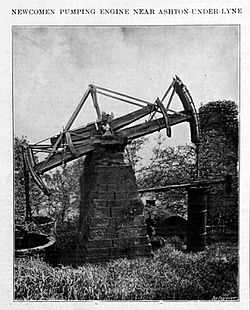Fairbottom Bobs facts for kids
Quick facts for kids Fairbottom Bobs |
|
|---|---|

On the original site, 1886
|
|
| Origins | |
| Type | Newcomen-type atmospheric engine |
| Designer | Thomas Newcomen |
| Date | 1760 or 1764 |
| Former operator | Cannel Colliery, Fairbottom near Ashton-under-Lyne, England |
| Measurements | |
| Cylinders | 1 |
| Bore | 28 inches (71 cm) |
| Stroke | 8 feet (2.4 m) |
| Preservation | |
| Collection | Henry Ford Museum |
| Location | The Henry Ford, Dearborn, Michigan, United States 42°18′12.90″N 83°14′2.68″W / 42.3035833°N 83.2340778°W |
Fairbottom Bobs is a very old steam engine that was used in the 1700s. It was a special type called a Newcomen-type beam engine. Its main job was to pump water out of a colliery (a coal mine) near Ashton-under-Lyne in England.
This engine is super important because it's probably the second-oldest working steam engine still around today! It was first set up at Cannel Colliery in a place called Fairbottom around 1760 or 1764. People in the area started calling it Fairbottom Bobs.
The exact beginning of this engine isn't fully clear. It might have been used somewhere else first, possibly at Norbury Coal Works.
Contents
How Fairbottom Bobs Worked
The design of Fairbottom Bobs was quite simple for its time. It wasn't as powerful as later steam engines, but it got the job done!
Engine Power and Size
This engine had a power of about 11 horsepower. Imagine, that's like 11 horses working together! Its main cylinder was about 28 inches (710 mm) wide and the piston moved 8 feet (2.4 m) up and down.
Pumping Water from Mines
Fairbottom Bobs was connected to a water pump. This pump could lift water from deep inside the mine, about 240 ft down. It did this by making 14 strokes (up and down movements) every minute.
The Wooden Beam
A big wooden beam was a key part of the engine. It was made of a single strong piece of wood with metal straps. Iron chains connected this beam to the engine's piston. This beam rested on a stone pillar, not inside a building like many later engines. This suggests it might have been open to the weather.
Water for the Canal
The water pumped out by Fairbottom Bobs wasn't just thrown away. It was used to keep the water levels high in the nearby Ashton Canal. This helped boats move along the canal. The engine kept working even after the Cannel Colliery closed, because it was still needed to supply water to the canal. It finally stopped working around 1826 or 1827.
Saving Fairbottom Bobs
Today, Fairbottom Bobs is kept safe at the Henry Ford Museum in Dearborn, Michigan, in the United States.
Discovery and Move to America
By the late 1800s, people thought of the engine and its site as a historical treasure. Pictures from 1886 show it was still in pretty good shape. In 1927, Henry Ford, who started the Ford Motor Company, was looking for old industrial machines for his new museum.
His agent, Herbert F. Morton, found Fairbottom Bobs. Even though it had been left alone for about a hundred years and was in rough condition, its owner, Lord Stamford, gave the engine to the museum.
Restoration and Display
The engine was carefully taken apart and moved to the museum. Its original wooden beam was too old and rotten to keep, so a new one was made. The new beam was made very smooth, which was typical for how Henry Ford liked to restore things for his museum. The engine is now shown with a different type of boiler than its original, but one that looks similar to what it might have used.
Some parts of the original Fairbottom site, like the chimney base, are still there in England. People have even done archaeological digs there in 1982, 1990, and 2000 to learn more about the engine's history.

